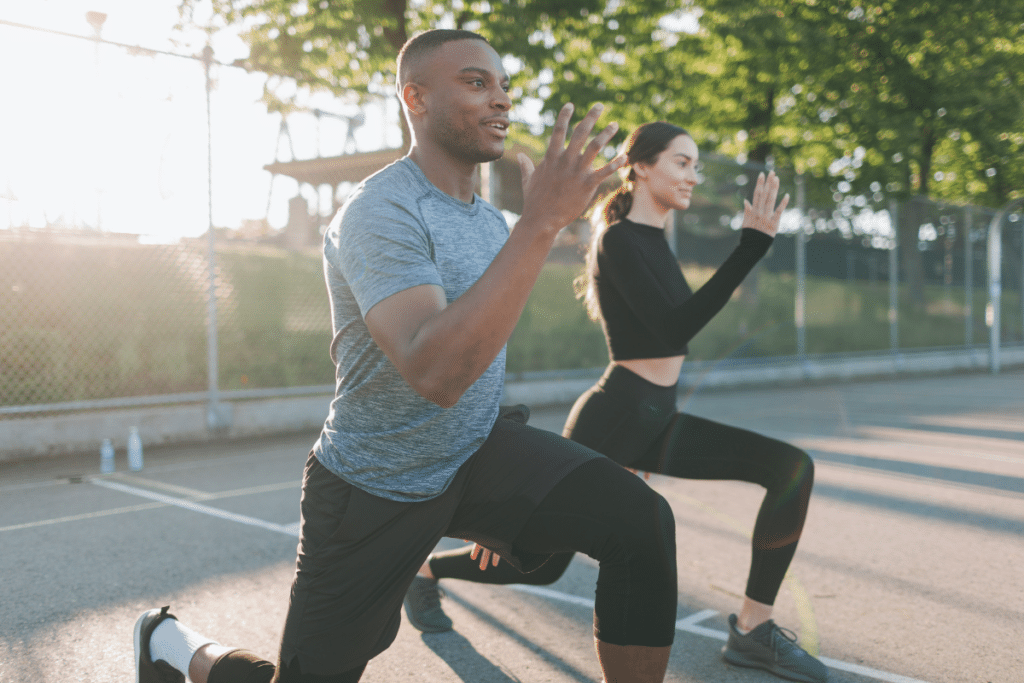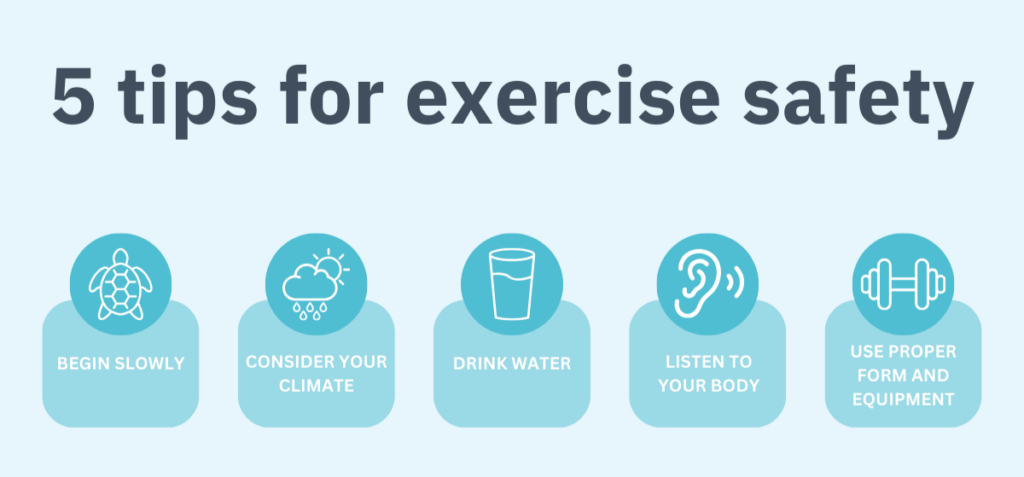
5 Tips for Exercise Safety
Regular physical activity has many benefits for health including protection against heart disease and type 2 diabetes. Exercise is safe for most individuals; however, any physical activity may lead to an injury, especially if not performed properly.
Common exercise-related injuries include back pain, knee pain, strains, and sprains. Other adverse events, such as dehydration or overheating, may also occur without proper planning.
Certain factors, such as age and fitness level, can increase your risk of injury. Implementing the following guidelines for exercise safety can help reduce the risk of developing an injury.

1. Begin Slowly
Choosing the appropriate activity type, duration, and frequency of exercise can help reduce the risk of injury. Individuals who are more physically fit can endure more intense physical activity than those who do not exercise regularly.
According to the Physical Activity Guidelines for Americans, the safest options are moderate-intensity and low-impact activity. Walking, bicycling, dancing, golfing, and swimming tend to have the lowest injury rates, making them safer forms of exercise.
Although these activities have low injury rates, it’s important to ensure that your environment is safe for exercise. When choosing where to be active, look for the following:
- Designated, well-maintained areas without holes or obstacles
- Other people being active or supervising the area (e.g., a lifeguard)
- Physical separation from motor vehicles (e.g., bike lanes, sidewalks, walking paths)
- Suitable lighting
To enhance physical fitness, workout duration and frequency can be increased gradually.
Activity level increases, such as adding 15 minutes to your workout, can be incorporated about every one to two weeks for children and young adults. For older adults, increasing activity level requires more time—about two to four weeks.
Pushing your body too hard or too fast is a common cause of exercise-related injuries.
Try to avoid increasing these factors at the same time:
- Duration
- Intensity
- Frequency
For most individuals, adding moderate physical activity to your daily routine is generally considered safe; however, some people may be at a higher risk of becoming injured.
The following individuals may need to exercise caution when starting a new exercise:
- Individuals with certain chronic health conditions
- Individuals with a sedentary lifestyle
- Individuals who are pregnant
- Older individuals
To find the best exercise plan for your unique needs, consult your integrative healthcare provider.
2. Consider Your Climate
Peak summer heat or winter chill may deter you from getting outside for physical activity, but staying active year-round is best for your health. Being outdoors during extreme weather puts additional strain on the body.
Muscle injuries and weather-related illnesses can occur if proper preparation and safety measures are not taken. Hot weather workouts can also put you at risk for dehydration and heat stroke.
When exercising during hot weather consider the following tips:
- Drink plenty of water before, during, and after exercise
- Exercise at dawn when it’s cooler
- Stay in the shade whenever possible
- Take frequent breaks
- Wear lightweight clothing
- Wear sun protection (e.g., hat, sunscreen)
Doing high-intensity activities in very cold weather, such as shoveling after a heavy snowfall, can increase the risk of a heart attack, dehydration, frostbite, and hypothermia.
Additionally, breathing cold, dry air can restrict your airway, causing shortness of breath, coughing, and wheezing.
To help protect yourself from illness or injury when exercising in the cold, consider the following tips:
- Decrease your pace or intensity as needed
- Drink plenty of water before, during, and after physical activity
- Insulate your head with a hat and your extremities with gloves and socks
- Warm up and cool down longer
- Wear layers of clothing
- Wear sun protection as needed
3. Drink Water
Evidence suggests that inadequate hydration can negatively impact exercise performance and potentially increase the risk of an injury. Drinking enough fluids before, during, and after exercise training can increase endurance and support overall performance.
The amount of water needed to maintain adequate hydration is different for everyone. To determine your unique hydration needs, it’s best to work with your healthcare provider.
Factors that can influence hydration needs include:
- Altitude and climate
- Body size
- Certain medical conditions (e.g., cystic fibrosis, diabetes, heart disease)
- Certain medications (e.g., diuretics)
- Exercise duration and intensity
- Sweating
If hydration levels become too low, dehydration can occur. Without proper care, dehydration can become serious, causing symptoms such as confusion, dizziness, labored breathing, gastrointestinal upset, and weakness.
Early signs of dehydration include:
- Dark colored urine
- Decreased exercise capacity
- Dry or cracked lips
- Fatigue
- Flushed skin
- Headaches
- Muscle cramps
- Thirst
The simplest way to access your hydration status is by checking the color of your urine. A large volume of pale- coloured urine typically indicates adequate hydration. Darker urine indicates that you need to drink more fluids.

Weighing yourself before and after exercise can also help you determine how much water was lost during physical activity.
Water losses equivalent to as little as 2% of body weight can impact cognitive and physical performance.
To stay hydrated when exercising for less than 90 minutes, consider the following guidelines.

4. Listen To Your Body
Listening to your body before, during, and after your exercise routine can help prevent injuries.
Having sore muscles after exercising is to be expected; however, high levels of exhaustion and pain may be signs that you’re overdoing it.
Exercise should not be painful, and if you experience pain while exercising, stop immediately.
If a mild injury has occurred, a regimen of cold therapy in combination with rehabilitative exercises (that do not worsen pain) may help alleviate symptoms. Functional supports, such as a compression bandage or brace may also be used to help manage swelling and pain.
If the injury does not seem to be getting better, or any of the following have occurred, contact your healthcare practitioner as soon as possible:
- Chest pain during or after exercise
- Joint appearing out of position or audibly popping out of place
- Serious injury, severe pain, or bleeding

5. Use Proper Form and Equipment
If you are new to an exercise or activity, it’s important to learn good form and invest in the proper equipment. Performing exercises incorrectly can lead to serious injuries.
Online videos, community lessons, fitness classes, and personal trainers are all resources that can be used to learn how to perform exercises properly.
Wearing appropriate clothing, shoes, and safety gear is also essential for preventing injuries. For example, wearing reflective clothing and lights when doing outdoor activities (e.g., bicycling, running) in the dark can help increase visibility.
Before starting a new activity, be sure to have all of the proper knowledge and equipment to stay safe.
Yours in Health,

Dr. Heather
Bkin, DC, Acupuncture Provider
